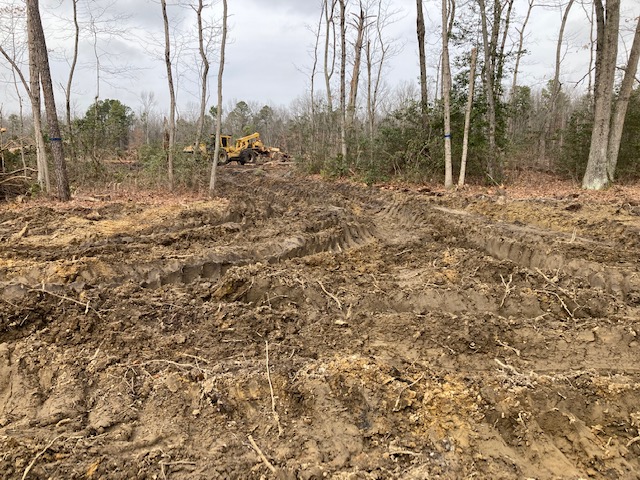New Jersey’s Wildlife Management Area system preserves an array of fish and wildlife habitats throughout the state. Glassboro Wildlife Management Area is located off Fries Mill Road in Clayton NJ (Gloucester County).
In early February 2023, nineteen acres of mature oak forests in Glassboro Wildlife Management Area (WMA) were destroyed by the state in order to create habitat for the American woodcock. The majority of destruction occurred in wetlands and wetlands transition areas that are supposed to be protected from this kind of activity. This included mature shortleaf pines and swamp chestnut oaks, as well as two rare plant populations.

‘Forestry’ is generally defined as the science or practice of planting, managing, and caring for forests. In New Jersey, this term is widely applied to label many destructive activities—including clear-cutting—as permissible ‘forestry’ practices; however, what transpired in Glassboro is too extreme to qualify for even this overly-generously categorization. This was land conversion, because the stumps were removed and the pristine, ancient soils beneath were bulldozed. If proper procedures had been followed, this never could have received a forestry plan approval or have obtained a general permit for wetland habitat restoration.
Mature forest was being converted to grassland to create habitat for the American Woodcock— this is a species of “low conservation concern”, so the goal of this habitat-creation was simply to create more game-hunting grounds. For this additional recreation opportunity, New Jersey has paid a steep price—both ecologically, and financially.
New Jersey Department of Environmental Protection (NJDEP) staff initially wrote off the concerns of conservation groups, describing the destruction as the “restoration and expansion of previously existing fields targeted for meadow/pollinator mix and scrub/shrub habitat.” They justified their actions as being “well vetted through our internal review process (LMR) and Jason Hearon and staff coordinated the project in close coordination with the Forest Service.” NJDEP staff have started to shift their position on this issue, informally acknowledging that mistakes were made; we are still waiting for an official statement and formal investigation of the matter.


The damage has been done, but we can make sure that this can’t happen again. We intend to hold NJDEP accountable, and to get relevant legislation and rules passed. This blunder comes on the heels of a forestry task force report that called for greater accountability for all forestry plans. This project should have been subjected to a 14-step public review process. If given the opportunity, local experts could have suggested more suitable plots of land for Woodcock habitat-creation that would not have required the destruction of wetlands. It is essential that the recommendations of the forestry task force be codified through legislation. Furthermore, it is important that these laws and subsequent rules be authored by a science commission with deep knowledge of the underlying science.
Current status
As of 3/25/2024, work is currently being carried out on the site by contractors with no supervision by NJDEP staff. The work raises the following issues:
No sediment control, such as straw or a silt fence, is being used. As a result, sediment is entering the wetlands, which was especially evident following the 3-4 inches of rainfall on 3/23/24.
Huge soil-crushing machines are being driven all over the sprouting plants in order to install what appears to be a permanent fence.
The heavy fence is being installed against the wetland where trucks should not be permitted to drive. Stumps with soil on the roots are being pushed into the spung / wetlands.
Trucks are being parked right on top of the archaeological sites, and they are tearing them up with tire movements and traffic.
PPA has not received any formal response from the NJDEP to our public comments (submitted on 2/14/2024) and we now also await a response to our 3/25/2024 letter that raises the issues described above.
The initial 2023 violation was covered by the following news outlets:
- NJ.com on 3/16/2023.
- NJ Spotlight News on 3/13/2023, 4/13/2023 and 4/28/2023.
- The New York Post on 3/15/2024.
- The Associated Press on 4/14/2023.
- The Philadelphia Inquirer on 4/14/2023.
Timeline
February 2023 (exact start date unknown): NJDEP Division of Fish and Wildlife begins an unlawful land conversation project, skipping the public 14-step process that NJ law requires to solicit public feedback before undertaking any such projects on public land.
March 6, 2023: Conservation organizations (the New Jersey Conservation Foundation, Pinelands Preservation Alliance, South Jersey Land and Water Trust, and Citizens United to Protect the Maurice River) sent a letter to NJDEP leaders and Senator Bob Smith to alert them to the problem. Read the letter online.
March 10, 2023: NJDEP suspended this project on March 10, 2023
April 6, 2023: NJDEP’s Bureau of Coastal and Land Use Compliance and Enforcement issued a notice of violation to the NJ DEP’s Division of Fish and Wildlife
December 20, 2023: NJDEP announced the proposal of a restoration plan to address the freshwater wetlands violation (page 4 of this bulletin).
February 16, 2024: 60-day public comment period closes. Read the 2/14/2024 comment letter that Pinelands Preservation Alliance and local ecological experts submitted online.
February 24, 2024: Staging observed on the property (potentially present weeks earlier), including a storage trailer, porta potty, fence posts and wire fencing on site.
March 22, 2024: Heavy equipment, pick-up trucks observed working on the site, including a Cat 225 (or similar) operating directly on top of the archaeological dig site that we had warned must be avoided.
March 25, 2024: PPA and NJCF send a letter to the NJDEP Commissioner “to express our deep disappointment in the way that the restoration of the Glassboro Wildlife Management Area is being carried out.” Read the full letter online.